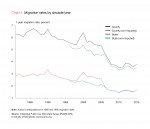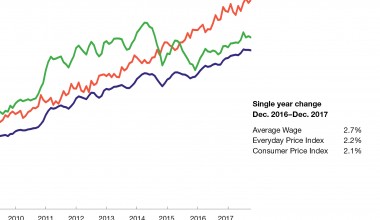A Drop in Job-Related Moves Suggests a More Efficient Economy
The decline in migration among all demographic groups implies a fundamental change. The next question, then, is whether this change reflects the growing costs of migration or its diminishing benefits. New barriers to migration are a bad development. But if the economy is evolving so that we can realize the economic gains usually associated with migration without people having to move as much, it could be a very good change.
Many explanations have been offered for declining migration, such as not being able to sell a house (“housing lock-in”), older workers wanting to stay in place, and dual-career couples having difficulty finding two jobs in a new location. I propose another explanation: New information technology has made it easier for people to find new jobs in their current location. Fewer people moving is not a sign of economic inflexibility but of a more efficient economy.
Overall migration trends point down
Migration rates in the U.S., that is, the percentage of people moving, have been falling since about 1990 (Chart 1). In Chart 1, data for gauging movement within the U.S. are not actual counts of people moving but are approximations based on the Current Population Survey. The lines labeled “State” are estimates of the percentage of U.S. adults who moved between U.S. states in the past year, and the “County” lines are for those who moved between counties. Short-distance moves within counties are not shown.
Overall, migration nearly halved from 1981 to 2015. County-level migration was between 6 percent and 7 percent a year in the 1980s and has dropped to between 3 and 4 percent in recent years. State-level migration has fallen from about 3 percent to 1.5 percent. Since each percentage point represents about three million people, this is 5–10 million fewer Americans moving each year than if migration had stayed at the 1990 level.
From 1996, the chart shows two lines for each state and county-level migration. When survey data are missing, statisticians sometimes use estimates to fill in incomplete survey results. After 1996, there is a data quality flag available to know if this process, called imputation, was used on any migration questions. Whenever available, we show both the overall migration estimates and estimates using only non-imputed data. This typically makes little difference, but in a research paper published in 2012, two economists pointed out that the imputation procedure used for 1999– 2005 overestimated migration. As the reader can see in Chart 1, there is indeed an apparent rise in migration in this time period, but the non-imputed data suggest that this time period shows the same steady decline in migration as the years immediately before and after.
Explaining the decline: changing costs or benefits
One of the most common reasons for long-distance moves is for better job opportunities. Many studies show that people who migrate within the U.S. earn higher wages after their move. Despite this, there has been a drastic decline in internal migration over the past 30 years through expansions and recessions alike. Either these types of moves are getting harder or they are becoming less valuable. This is a difficult distinction to make, but it is the crucial one for figuring out what to make of the decline.
Either interpretation is reasonable. There are demographic reasons to believe that migration would have become more difficult in recent years. The U.S. population has gotten older, and young people tend to be the least tied down and the most mobile. A second reason is the growing number of dual-career couples. If both spouses work, the gain from a move that furthers one spouse’s career might be offset by disruption to their partner’s prospects.
While these demographic shifts are certainly happening, they are only a small part of the story. Were these trends the primary factors explaining declines in migration, we would expect to see declines concentrated among older and married households. In fact, we see just the opposite in Table 1: Migration rates have declined for all ages and marital status. In addition, the long-term decline covers both the housing boom and bust and other ups and downs in the economy, so it cannot easily be explained by factors such as housing lock-in or economic conditions. Overall, the decline for all demographic groups implies that a more fundamental change in the economy is responsible for the decline in migration.
After ruling out the demographic or housing-related reasons discussed above, it is difficult to come up with reasons that moving should be more expensive or more difficult now than it was 30 years ago. If a person is thinking of moving to a new city, he or she can find online postings for jobs and housing for any city in America in a tiny fraction of the time that it would have taken to gather similar information in the pre-Internet era. Facebook, cell phones, Skype and other forms of social media ease the separation from family, friends, and support networks that come with making long-distance moves. These are not perfect substitutes for actual proximity, of course, but they are better than what people had before. Moving still might be hard, but it shouldn’t be harder.
Therefore, something must be making migration less beneficial. This is a difficult question to study. While it is relatively simple to measure migration, it is almost impossible to determine when people could have chosen to move but decided not to. Still, economists have presented arguments in favor of several theories. One is that labor markets are becoming more alike. A person with specialized talents doesn’t have to move to find a job that matches his or her talents because suitable jobs are increasingly available anywhere. A more speculative explanation is that the aging of the population indirectly has affected migration by changing how businesses recruit. The argument is that as the workforce gets older, people are less willing to move. This causes companies to put more effort into recruiting locally instead of nationally. Then even young workers who would be willing to move are more likely to find jobs locally. These theories are still debated by economists, with evidence both for and against.
I propose a different explanation. The easier flow of information brought on by technology does make it easier for a person to migrate – but it also makes it easier for a person to find a better job without migrating. If people prefer not to migrate, then it may be that people today are more likely to find a good job nearby rather than relying on a job transfer or promotion to another city or state.
In research currently underway, Kyle Mangum, assistant professor of economics at Georgia State University, and I present two major facts to support this case. First, if it is easier to find a good job match, then we argue that workers today should see more favorable wage changes by staying put. Second, if people are more often looking for jobs locally, we would expect to see migration fall the fastest in cities where the most upward mobility is possible. We compared migration rates and income changes in 1981– 95 to 1996 – 2010 to show that these arguments are supported by the data. The decline in migration is in fact concentrated in the most mobile cities, which also tend to have the highest wage dispersion. It has hardly declined at all in the least mobile cities. We also found that at all levels of education, workers in more recent years are more likely to see year-to-year wage increases.
We view these results as a good sign for the economy – taken together, they show that internal migration is declining, but this does not indicate a less fluid or dynamic national labor market.







